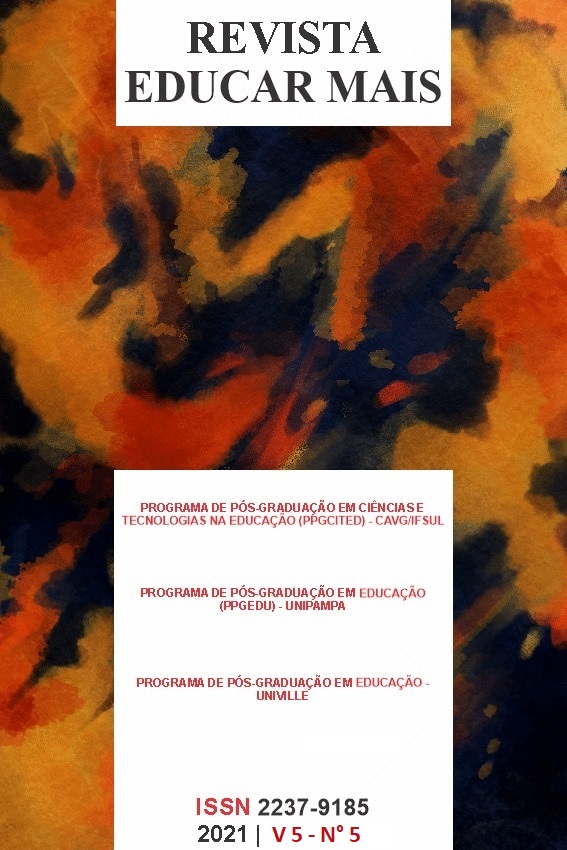Women and the new textbooks in integratives projects of Natural Science
DOI:
https://doi.org/10.15536/reducarmais.5.2021.2471Keywords:
Science Teaching, Science textbooks, Women in ScienceAbstract
Throughout history, women have been prevented from participating in formal education, a scenario that has changed in recent decades. Today everyone has the right to education in most of the world. Once the access was resolved, the next step is recognition since the contribution of women is still little recognized. Authors such as Rosa and Silva (2015) and Bianchi (2020) showed that the problem is reflected in the textbook. The present work aimed to investigate the female representation in the books of Integrative Projects in Natural Sciences of the new National Textbook Program (PNLD, in Portuguese) of 2021. In a qualitative-quantitative approach, gender equity was analyzed in five parameters: representation in images, number of authors, references, citations and technical team. The result was positive for images, authors and staff. In addition, it was found that the female protagonism in social/environmental activism was exalted. However, contradictions persist, given the disproportionality of references and citations from women when academic production has reached equity. Thus, we show that there is progress, but that the discussion must continue until we reach equity.
Downloads
References
BELMIRO, Celia Abicalil. A imagem e suas formas de visualidade nos livros didáticos de Português. Educação & sociedade, v. 21, n. 72, p. 11-31, 2000.
BIANCHI, Madge. et al. Representações de gênero: como as mulheres cientistas e suas contribuições são representadas nos livros didáticos de Física, Química e Biologia. In: Anais SECITEC 2019 – Semana da Ciência e Tecnologia, v.4, n.1, 2019, Luzerna, SC.
BIANCHI, Madge. Representatividade das mulheres na ciência: visibilidade através do livro didático de física. In: XVIII Encontro de Pesquisa em Ensino de Física - 2020, 2020, Luzerna, SC.
BRASIL. Base Nacional Comum Curricular. Brasília, 2017. Disponível em: <http://basenacionalcomum.mec.gov.br/images/BNCC_20dez_site.pdf>. Acesso em: 12 mai. 2021.
DIEDRICH, Bruna. “Falar em filósofas é falar em revolução”: representação feminina no ensino de Filosofia. Monografia (Graduação) - UFRGS, Porto Alegre - RS: 2018.
DINIZ, Cristiane. Desigualdades e reconhecimentos: memórias de uma escrita feminina e afro-brasileira. Dissertação (Mestrado) - UNIMONTES, Montes Claros - MG: 2014.
FAPESP, Em busca de equilíbrio. Revista Fapesp, edição 254. São Paulo, 2017.
IBGE, Estatísticas de Gênero. Brasília, 2010. Disponível em: <https://www.ibge.gov.br/apps/snig/v1/?loc=0&cat=-1,1,2,-2,-27,112,113,114,128&ind=4741>. Acesso em: 12 de mai. 2021.
LIMA, Betina Stefanello. Teto de vidro ou labirinto de cristal? As margens femininas das ciências. Dissertação (Mestrado) - Universidade de Brasília, Brasília, 2008.
MAGALHÃES, W. DE A. M.; PEREIRA, A. L. S. O uso da aprendizagem baseada em problemas no ensino técnico: projetos integradores como experiência interdisciplinar. Revista de Estudos e Pesquisas sobre Ensino Tecnológico (EDUCITEC), v. 5, 12, 2019.
ONU MULHERES. Princípios de empoderamento das mulheres. 2017. Disponível em: <https://www.onumulheres.org.br/wp-content/uploads/2016/04/cartilha_ONU_Mulheres_Nov2017_digital.pdf>. Acesso em: 12 de mai. 2021.
PRODANOV, Cleber Cristiano; DE FREITAS, Ernani Cesar. Metodologia do trabalho científico: métodos e técnicas da pesquisa e do trabalho acadêmico. 2ª Edição. Editora Feevale, 2013.
MEC, Guia Digital do PNLD, Brasília, 2021. Disponível em <https://pnld.nees.ufal.br/assets-pnld/guias/Guia_pnld_2021_proj_int_vida_Apresentacao.pdf>. Acesso em 10 de abr. 2021
ROSA, Katemari; DA SILVA, Maria Ruthe Gomes. Feminismos e Ensino de Ciências: análise de imagens de livros didáticos de Física. Revista Gênero, v. 16, n. 1, 2015.
SIQUEIRA, Gisele. “E onde estavam as mulheres?” a presença das mulheres nos livros didáticos de História do ensino médio (2015 – 2017). Trabalho de Conclusão de Curso (Licenciatura em História) - Instituto de Ciências Humanas, Comunicação e Artes, Curso de História, Universidade Federal de Alagoas, Maceió, 2019.
TOKARNIA, Mariana. Mulheres assinam 72% dos artigos científicos publicados pelo Brasil. Agência Brasil. Brasília, 2019.
Downloads
Published
How to Cite
Issue
Section
License
Copyright (c) 2021 Thaynara Beatriz Selasco de Matos, Ana Cecilia Soja

This work is licensed under a Creative Commons Attribution-NonCommercial 4.0 International License.
DECLARATION OF RESPONSIBILITY: I hereby certify that I partially or fully participated in the conception of the work, that I did not hide any links or financial agreements between the authors and companies that may be interested in this article publication. I certify that the text is original and that the work, partially or fully, or any other work with a substantially similar content written by me, was not sent to any other journal and it will not be send while my submission is being considered by Revista Educar Mais, whether in printed or electronic format.
The author responsible for the submission represents all the authors of the manuscript and, when sending the article to the journal, guarantees s/he has obtained the permission to do so, as well as s/he guarantees the article does not infringe upon anyone’s copyright nor violate any proprietary rights. The journal is not responsible for the opinions expressed.
Revista Educar Mais is Open Access, does not charge any fees, whether for submission or article processing. The journal adopts Budapest Open Access Initiative (BOAI)’s definition, i.e., any users are permitted to read, download, copy, distribute, print, search and link to the full texts of these articles.
All the articles are published under the Creative Commons Atribuição-NãoComercial 4.0 Internacional license. The authors keep the copyright of their production. That way, they must be contacted directly if there is any interest in commercial use of their work.
















